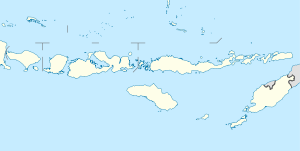West Malaka
| Kecamatan Malaka Barat West Malaka District
|
|
|---|---|
 Administrative division of the Indonesian West Timor |
|
| Basic data | |
| Country | Indonesia |
| province | East Nusa Tenggara |
| Government district (Kabupaten) | Malaka |
| Seat | Besikama |
| surface | 87.4 km² |
| Residents | 20,684 (2015) |
| density | 237 inhabitants per km² |
| ISO 3166-2 | ID-NT |
Coordinates: 9 ° 39 ′ S , 124 ° 55 ′ E
Location in East Nusa Tenggara Province |
West Malaka ( Indonesian Malaka Barat ) is a district ( Kecamatan ) of the Indonesian administrative district ( Indonesian Kabupaten ) Malaka ( East Nusa Tenggara Province ) on the island of Timor .
geography
West Malaka is located in the south of the Malaka administrative district on the coast of the Timor Sea . To the north are the districts of Weliman and Central Malaka and to the west the district of Wewiku . West Malaka has an area of 87.41 km².
The district is divided into 16 villages ( Desa in Indonesian ): Besikama , Fafoe , Lasaen , Loofoun , Maktihan , Motaain , Motaulun (Mota Ulun), Naas , Oan Mane , Rabasa , Rabasa Haerain , Rabasa Hain (Rabasahain) , Raimataus , Sikun , Umalor and Umatoos . Six of the villages are on the coast.
In the region, rainy and dry seasons alternate. In 2015, 63 days per year and 939 mm of precipitation were recorded. In the previous year there were 74 rainy days and 1,864 mm.
Residents
In 2015 there were 20,684 people (9,887 men and 10,797 women) in West Malaka, the majority of whom were members of the Bunak and Tetum . The majority of these ethnic groups live in the state of East Timor . In 2015 the population grew by 2.08%.
Of the people living in West Malaka in 2015, 2,453 were in the 0 to 4 age group (2014: 2,423). The over 75 age group had 431 residents (2014: 425).
economy
Most of the people in the district make a living from agriculture. In the fields in West Malaka, 9.02 km² of rice, 4.17 km² of maize and cassava are planted.
1,448 households are connected to the electricity network, which corresponds to 26.97% of all households in the district. While in Umatoos 507 households, in Besikama 177 households, in Fafoe 175 households and in Oan Mane 150 households have an electricity connection, in the other villages the figure is less than 100 households. Loofoun has a solar power system for the supply. In 2014, the first ten households in Motaain were connected to the public power grid.
Each village has the largest number of PLN electricity subscribers in Umatos village, 507 households, Besikam village has 177 households, Fafoe village 175 households and Oan Mane 150 villages. a different number of households PLN electricity subscribers under 100. Contrary to the problems mentioned above, there are several villages in West Malaka district whose households do not use PLN electricity like Loofoun village. Of the above problems, most people use solar power plants, because until now household data PLN electricity users are still. While there were no households using PLN electricity in the village of Motaain a year earlier, this year there were 10 households using PLN electricity.
Public facilities
There are 20 elementary schools, five junior high schools, and two senior high schools in the district.
Web links
- STATISTICS DAERAH KECAMATAN MALAKA BARAT 2016 - Statistical data from West Malaka 2016 (Indonesian, English).
